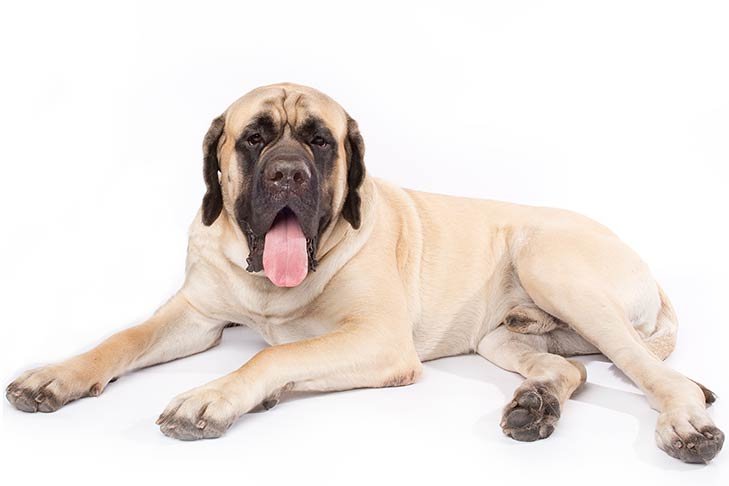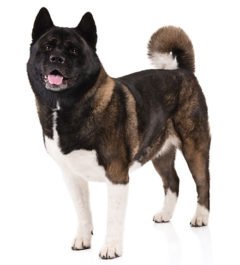Mastiff (English)
BREED INFO
- Group – Working
- Height – 26-30 inches at the shoulder
- Weight – 80-86 KG
- Life Span – 10-12 years
The Mastiff is a gentle dog, despite his striking size and appearance. He makes a great watch dog and loyal companion. This dog develops enduring bonds with his family and is best suited to living in the country or suburbs where he can have lots of space.
History

The word “Mastiff” describes a group of giant dogs rather than a single breed. All Mastiffs supposedly originated in Asia many thousands of years ago. The Old English Mastiff ancestors of today’s Mastiff breed were bred as watch and guard dogs in England for over two thousand years. Mastiffs were favored by peasants and poor farmers to control wolves and other savage predators and to protect sheep and other livestock. These dogs also were trusted guardians of home and family, and they eventually became valued companions in addition to their working traits. The Mastiff was also prized by English nobility for its excellent pack hunting skills, protective nature and loyalty.
Records of Mastiff ancestry are not reliable before the 19th century. In earlier times, every fancier seemed to claim the greatest age and most admirable history for his particular Mastiff-type dogs. Nonetheless, there are ancient Egyptian drawings of typical Mastiffs dating back to 3000 B. C. One of the earliest Chinese references to the Mastiff dates to 1121 B.C. Obviously, modern Mastiffs come from ancient ancestral lines. Herodotus told of Cyrus the Great, founder of the Persian Empire, receiving a Mastiff as a gift from the King of Albania in about 550 B.C. Cyrus apparently set this dog against another and also against a bull, but his Mastiff was “meek,” so Cyrus had it destroyed. Legend has it that news of this came back to the King of Albania, who sent a Mastiff bitch to Cyrus, telling him that “a Mastiff was no ordinary cur and that it scorned to notice such common creatures as a Persian dog or a bull.” According to legend, the King of Albania urged Cyrus to select a more worthy opponent for his new Mastiff, such as a lion or perhaps an elephant, and ended his communication by saying that Mastiffs “were rare and royal,” and that he would not send Cyrus another. Reports from the time indicate that Cyrus’ Mastiff bitch was set upon an elephant and fought with such fury and efficiency that she took the elephant to ground.
In his account of invading Britain in 55 B.C., Julius Caesar describes Mastiffs as having fought gallantly beside their English owners. Shortly thereafter, stories surfaced about giant British fighting dogs brought back to Rome, where they were used in public combat competitions matched against bulls, bears, lions, tigers and human gladiators. The use of Mastiffs in the Colosseum explains their name. “Mastiff” is a corruption of the Roman word “mansuetus,” meaning “tame.” The Mastiffs were the only “tame” animals fighting for their lives in the Roman arena. All other competitors were wild. While today it is easier to pretend that these cruel spectacles were only popular in ancient times, that is far from the truth. Bull-baiting, bear-baiting and dog-fighting were respectable “gentlemen’s sports” in both England and America during the last two centuries, patronized by royalty, clergy and commoners. Organized underground dog-fighting, although illegal in the United States and many other countries, unfortunately continues to this day.
Another well-known story about the Mastiff involves Sir Peers Legh, Knight of Lyme Hall (near Stockport, Cheshire). He brought a favorite Mastiff bitch to the Battle of Agincourt in France, which took place in October of 1415. When Sir Legh fell during battle, she stood over him and defended him for relentlessly. Days later, he was picked up by English soldiers and carried to Paris, where he died of his wounds. The faithful Mastiff was returned to the Lyme Hall Kennels in Cheshire, England, where she became the foundation for the famous Lyme Hall line of Old English Mastiffs. The modern Mastiff descends from the lines of Lyme Hall and those of the Duke of Devonshire’s Kennels at Chatsworth, Chaucer.
At least 600 years ago, Mastiffs were hunted in packs in England on lion, deer and other large game. White and piebald Mastiffs, some with long coats, are well-documented in the breed history. Dog-fighting and animal-baiting were made illegal in England in 1835, but the blood-sport continued for twenty years or more with participants openly flaunting the law. The Mastiff-type dogs were always front and foremost in the underground fights. Nonetheless, the breed’s numbers dwindled when pit-fights became forbidden. There were 63 Mastiffs entered at an English dog show in 1871; by 1908, none were entered in the same show, and only 35 Mastiffs were registered with the Kennel Club (England). In 1945, there were only 8 Mastiffs of breeding age in all of Great Britain.
The American Mastiff Club was founded in 1879, and for some reason thereafter disbanded. The present club was re-established in 1929. The American Kennel Club recognized the Mastiff in 1885, as a member of the Working Group. Mastiffs nearly died out during World War II, but today they have recovered in number and are extremely popular world-wide, both as companions and as strong competitors in the conformation show ring.
Personality and Temperament
Mastiffs rarely bark, but will defend their territory and family. These dogs are very confident, dignified, and gentle-natured.

This breed is usually good with children, and if properly socialized at an early age, they get along well with other dogs and most household pets.
Hair, Care and Grooming
Outercoat straight, coarse and of moderately short. Undercoat dense,short and close lying. The Mastiff has many special needs, including diet and bedding. Dead and loose hairs can be removed with a rubber brush during the times of shedding.
Health
This breed is prone to hip dysplasia, bloat, chronic heart disease, gastric torsion, ectropion, persistent pupillary membrane (PPM), vaginal hyperplasia, elbow dysplasia, and progressive retinal atrophy.
Training and Activity
This breed requires mutual respect in training, with consistency and understanding thrown in for good measure.

Although when young, the Mastiff is so full of energy its activity needs to be controlled, as an adult it has rather average exercise needs.
Feeding
Mastiffs are large dogs and require a similarly healthy-sized diet, but the real danger of overfeeding an under exercised dog means that you shouldn’t necessarily feed them too much. It’s a good idea to keep your Mastiff well-enough fed that its mood and general health do not suffer. These dogs enjoy a good cut of meat and a lot of meat-flavored food, so even flavoring other kibbles or even vegetables with meat can be a great treat for Mastiffs.






